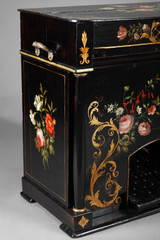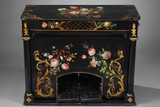A wooden bellows parlor harmonica, raised on a small four-legged platform with a cut-out opening in the front for the pedals. It features rich polychrome and gilt decoration of bouquets of flowers and foliage on a black background. This antique musical instrument has two gilt bronze side handles. The keyboard cover is in two hinged, folding sections. The craftsmanship is typical of the Napoleon III period. This instrument most likely comes from a private collection (bourgeois home, château, etc.) dating from the 1860s or 1870s. It is remarkable for its exquisite decoration. At that time, it was used to accompany voices or instruments (such as the violin). The instrumental section has only one obbligato register, in the style of a melody guide. Condition Report: In good overall condition, with slight wear to the gilding, some minor scratches, and cracks in the wood. Several keys are depressed. A restoration of the musical section can be carried out by Jean-Jacques Mounier, Master Organ Builder, for a total of €3,800 including VAT. Following this work, it will be pleasant to hear and play, and will represent a rare and sought-after collector's item. Background: The harmonium is a reed organ that vibrates under the effect of air blown by bellows. Those of this upright harmonium are operated by pedals. The harmonium, derived from Grenié's expressive organ, was invented in Europe by the Frenchman Alexandre-François Debain (1809-1877), who patented it in 1842. In the 19th century, harmoniums were popular, particularly in small churches and chapels, but could also be found in the homes of the aristocracy and the upper middle class. Napoleon III period, Circa: 1860 Dim: L:87cm, D:40cm, H:71cm.
- Reference :
- 2447
- Availability :
- Sold
- Width :
- 87 (cm)
- Height :
- 71 (cm)
- Depth :
- 40 (cm)
- Identify Exists:
- False
























